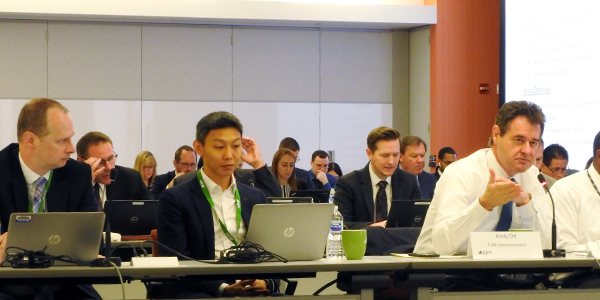By Christen Smith and Rich Heidorn Jr.
VALLEY FORGE, Pa. — PJM stakeholders approved a charter on Thursday for a senior task force dedicated to implementing market rule changes in the wake of the 890 million-MWh GreenHat Energy default.
“The board message is quite clear that it’s not going to happen again,” Vince Duane, PJM’s general counsel of law, compliance and external relations, told the Markets and Reliability Committee. “If we are going to offer products that present this kind of risk, we need to be robust and confident that we can manage the risks associated with it.”
The Financial Risk Senior Management Task Force will assemble beginning May 2 to consider changes to credit and risk management requirements, market rules, membership qualifications and the stakeholder process in response to an independent probe of the default that uncovered structural flaws. PJM wants stakeholders to form solutions and make recommendations for Tariff and Operating Agreement revisions to the MRC and Board of Managers by the end of year.
“It’s not lost on any of us at PJM that this is going to be an investment of time and resources, and we want to make sure it’s efficient and that we are risk-managing products that are being used and are valuable,” Duane said. “If it doesn’t meet that litmus test, I think we have to ask why we are doing it.”
The PJM Board of Managers released the independent review of the GreenHat debacle in March. The report concluded naive staff and weaknesses in the RTO’s credit rules allowed the small trading company to amass the largest portfolio of financial transmission rights in PJM history without the financial resources to cover its losses. The latest estimates suggest the default will cost members up to $430 million. (See PJM: FERC Order Could Boost GreenHat Default by $300M.)
CEO Andy Ott told the Market Implementation Committee on April 10 he will oversee organizational and procedural changes within the RTO but will rely on stakeholders to guide the process for market rule changes. Some of those internal changes include hiring a chief risk officer and replacing CFO Suzanne Daugherty, who retired before the release of the board’s report. The search for both is ongoing, Ott said Thursday.
Stakeholders endorsed the charter with just two objections and three ostensions. But several stakeholders expressed concerns about moving forward with the overhaul without the guidance of a CRO or CFO, noting the report’s recommendation to incorporate expert knowledge into the reforms.
The MRC delayed a vote on two proposals to allow surety bonds as a form of collateral until PJM hires the CRO and CFO. (See “Surety Bonds,” PJM MRC/MC Preview: April 25, 2019.)
“I think there are serious questions that should be reviewed,” said Susan Bruce, on behalf of the PJM Industrial Customer Coalition. “Maybe the answers become obvious. We have a responsibility to make sure that all of the products are delivering a value for this physical market. Retail customers shouldn’t end up being the insurance or backstop for products that aren’t delivering value.”
Greg Poulos, executive director of the Consumer Advocates of PJM States, mentioned his members’ interest in investigating the role of surety bonds, forfeiture rules and other FTR product specifics.
“Having the CRO in place is a critical component of leading these things … their perspective on surety bonds would be very helpful,” he said.
‘Action Plan’
Later Thursday, Ott gave the Members Committee a briefing on his “action plan” for responding to the default, which includes the creation of two new departments (Markets Risk Modeling, and Market Analytics and Surveillance); the realignment of the Law, Compliance and External Relations Division “to improve communication and coordination”; and the creation of a Risk Oversight and Markets Surveillance Committee to be chaired by the CRO with executive-level representation from Finance, Markets and Legal.
Ott said his goal is for PJM to improve its ability to identify “changes in behavior” by market participants to prevent future defaults. “I, for one, want my organization to get better,” he said.
The RTO would seek input from the Independent Market Monitor on tracking market participants’ positions, he said, but the IMM would not be involved in evaluating players’ credit and collateral.
Bruce Bleiweis of DC Energy questioned giving IMM Monitoring Analytics a role, saying market participants had warned the Monitor that GreenHat’s FTR position was “growing dramatically auction after auction. Yet we’re still where we are today.”
“You have no idea what went on, so don’t draw conclusions about things you don’t know,” Monitor Joe Bowring responded to Bleiweis. “It is our job … to monitor all parts of the market.”
Bowring said the default resulted from the failure to assess the risk posed by the interaction of GreenHat’s increasing positions and its “gaming” of the RTO’s credit requirements by adding FTRs in the opposite direction of its existing positions.
Greg Carmean, executive director of the Organization of PJM States Inc., said the RTO should consider whether it should take on a “financial regulator role” or whether it should allow another entity to sell FTRs and other financial products. If PJM retains the responsibility, he said, it should ensure that the cost of the expanded staff is borne by the “cost causers.”
Ott acknowledged PJM may rethink its “can-do culture,” which has led the RTO to take on new duties at stakeholders’ requests. “We can’t be all things to all people,” he said.




